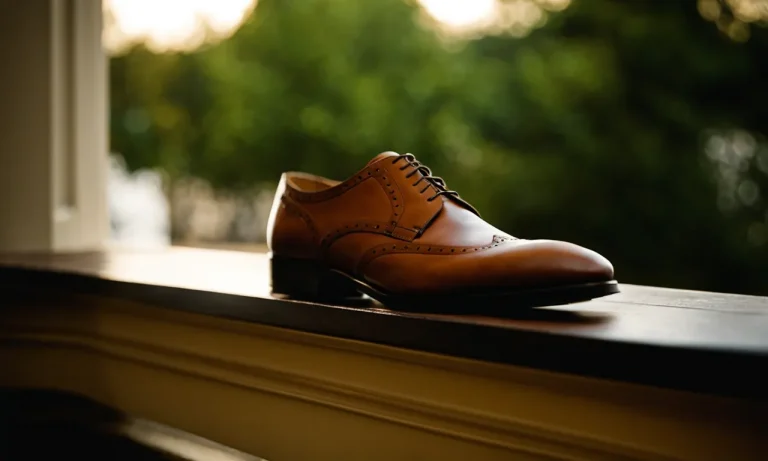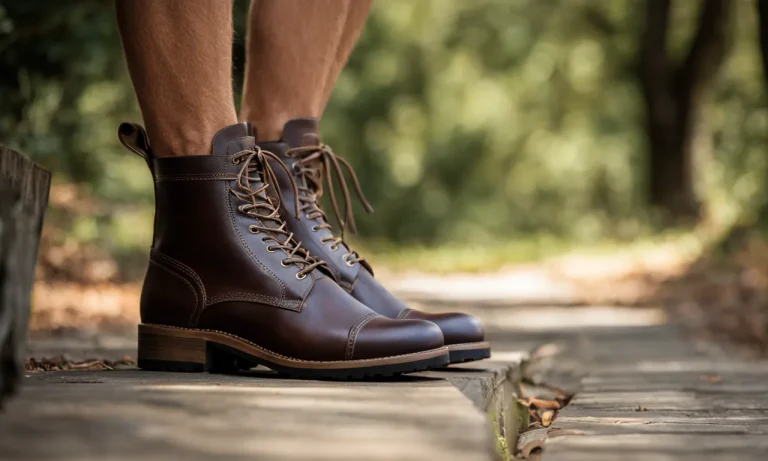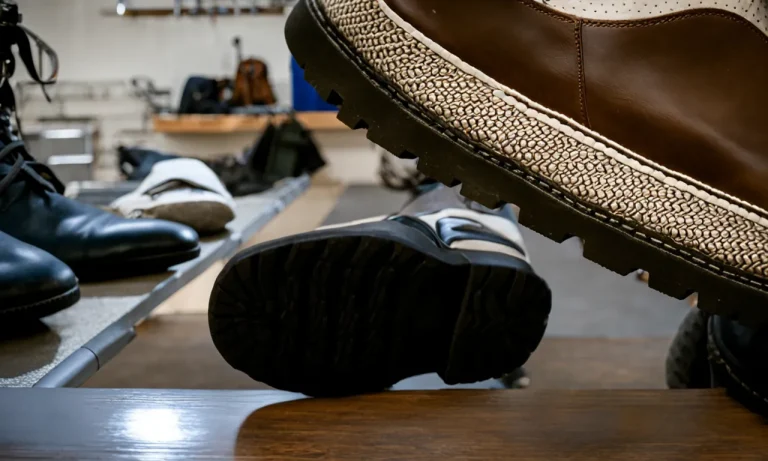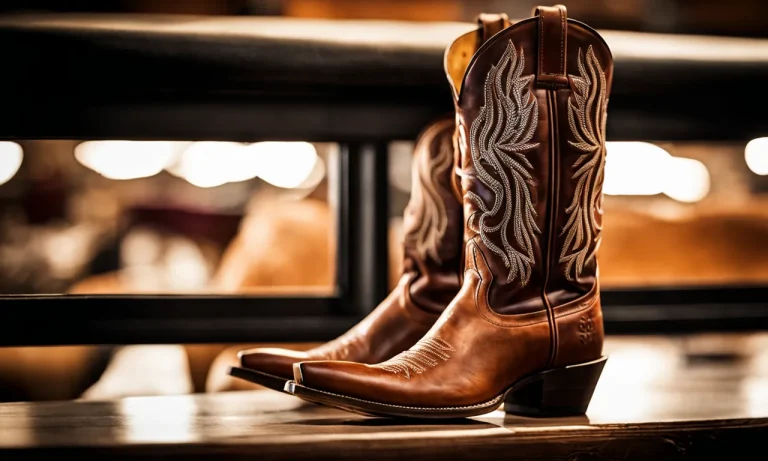If your favorite pair of shoes has seen better days, you may be wondering if Shoe Goo can bring them back to life. This clear adhesive has become a popular DIY shoe repair solution for fixing sole separation, worn heels, and holes or rips in the upper material.
If you’re short on time, here’s a quick answer to your question: Shoe Goo is an effective temporary fix for minor shoe damage, but it likely won’t stand up to heavy wear and tear over an extended period.
In this comprehensive guide, we’ll take an in-depth look at how Shoe Goo works, its pros and cons, tips for applying it properly, and whether it’s the best solution for your shoe repair needs.
What is Shoe Goo?
Shoe Goo is a popular shoe repair adhesive that has gained a reputation for its effectiveness in fixing worn-out shoes. It is a product made by a company called Eclectic Products, which specializes in creating adhesives and sealants for various applications.
Made by a company called Eclectic Products
Eclectic Products has been in the adhesive industry for over 40 years and has established itself as a trusted brand. Their experience and expertise in creating high-quality adhesives make Shoe Goo a reliable choice for shoe repair.
Clear silicone adhesive formula
Shoe Goo is formulated with a clear silicone adhesive that allows for seamless repairs. This transparent formula ensures that the repaired areas blend in with the original shoe material, making the repairs less noticeable.
Designed to bond to leather, rubber, plastic, and more
One of the notable features of Shoe Goo is its versatility in bonding to various materials commonly used in shoes. Whether it’s leather, rubber, plastic, or fabric, Shoe Goo can create a strong and durable bond, extending the life of your favorite pair of shoes.
Dries to create a flexible, waterproof patch
When Shoe Goo dries, it forms a flexible and waterproof patch that protects the repaired area from moisture and wear. This feature is especially beneficial for shoes that are exposed to challenging conditions, such as rain or snow.
Pros of Using Shoe Goo
Quick and easy to apply
One of the biggest advantages of using Shoe Goo is its ease of application. Unlike traditional shoe repair methods that require stitching or gluing, Shoe Goo comes in a convenient squeeze tube that allows for precise application.
Simply squeeze the adhesive onto the damaged area and spread it evenly with a spatula or your finger. It’s a hassle-free solution that saves you time and effort.
Dries transparent for seamless repairs
When it comes to repairing your favorite pair of shoes, you want the repairs to be as inconspicuous as possible. Shoe Goo dries transparent, ensuring that your repairs blend seamlessly with the rest of your shoe.
This means you can confidently fix any visible rips or holes without worrying about them being noticeable.
Can patch holes, rips, worn areas
Shoe Goo is a versatile adhesive that can be used to patch up various shoe problems. Whether you have a hole in the sole, a rip in the fabric, or a worn-out area, Shoe Goo can effectively repair it. Its strong adhesive properties bond well with different materials, providing a durable and long-lasting fix.
Adds traction to worn soles
Over time, the soles of your shoes can become smooth and lose their grip. Shoe Goo can help restore traction to worn-out soles, making them safer to walk on. By applying a layer of Shoe Goo to the bottom of your shoes, you can improve their grip on various surfaces, reducing the risk of slipping and falling.
Flexible when dry
One of the key features of Shoe Goo is its flexibility when dry. Unlike some adhesives that dry hard and brittle, Shoe Goo maintains a certain level of flexibility. This allows your repaired shoes to move and bend naturally, ensuring that the adhesive doesn’t crack or break under stress.
Waterproof seal
Another advantage of using Shoe Goo is its ability to create a waterproof seal. Whether you accidentally step in a puddle or find yourself caught in the rain, Shoe Goo can help protect your feet from getting wet.
Its waterproof properties prevent water from seeping into your shoes through any repaired areas, keeping your feet dry and comfortable.
Affordable price
Shoe Goo is an affordable solution for repairing your shoes. Compared to the cost of buying a new pair of shoes or taking them to a professional cobbler, Shoe Goo offers a cost-effective alternative. With a single tube of Shoe Goo, you can repair multiple pairs of shoes, saving you money in the long run.
Cons of Shoe Goo
Not a permanent solution
While Shoe Goo is known for its effectiveness in repairing shoes, it is important to note that it is not a permanent solution. Over time, the adhesive may start to wear off, especially with regular use. This means that you may need to reapply Shoe Goo periodically to maintain the repair.
Repeated flexing can cause it to detach
Shoe Goo is designed to be flexible, allowing your shoes to move naturally. However, excessive flexing and bending can cause the adhesive to detach from the shoe material. This is particularly true for areas that experience a lot of movement, such as the toes or the soles.
It is important to be mindful of this limitation and avoid putting too much strain on repaired areas.
Not ideal for large holes or sole separation
While Shoe Goo can work wonders for minor damage like small cracks or tears, it may not be the best solution for larger holes or serious sole separation. In these cases, it is recommended to consult a professional shoe repair service for a more comprehensive and long-lasting fix.
Can peel off over time
With extended use, Shoe Goo can start to peel off from the shoe surface. This can be more likely to happen when exposed to harsh conditions such as extreme heat or cold. It is important to be aware of this potential issue and take necessary precautions to protect the repaired areas.
May need reapplication every few months
As mentioned earlier, Shoe Goo is not a permanent solution, and you may need to reapply it every few months to maintain the repair. This can be an inconvenience for some individuals who prefer a more long-term fix for their shoes.
Not as durable as professional repair
While Shoe Goo can be a cost-effective and convenient option for minor shoe repairs, it is important to note that it may not be as durable as professional repair services. If you are looking for a more long-lasting and reliable solution, especially for expensive or cherished footwear, it is advisable to seek the assistance of a professional shoe repair specialist.
Tips for Using Shoe Goo
Clean and dry area thoroughly before applying
Before applying Shoe Goo to repair your shoes, it is important to ensure that the area you are working on is clean and dry. This will help the adhesive bond properly and provide a stronger and more durable repair.
Use a mild soap and water to clean the area, then allow it to dry completely before applying Shoe Goo.
Rough up smooth surfaces for better adhesion
If you are working with a smooth surface, such as leather or rubber, it is recommended to rough it up a bit before applying Shoe Goo. This can be done using sandpaper or a rough brush to create a slightly textured surface. This will help the adhesive adhere better and improve the overall bond.
Apply in thin layers, building up as needed
When applying Shoe Goo, it is best to start with thin layers and gradually build up as needed. This allows for better control and ensures that the adhesive is evenly distributed. Applying thick layers may result in a weaker bond and longer drying times.
Let dry 24 hours between coats
After applying a layer of Shoe Goo, it is important to allow it to dry for at least 24 hours before applying another coat. This drying time allows the adhesive to fully cure and strengthen the bond. Rushing the drying process may result in a weaker repair.
Avoid excess stretching/bending while curing
While Shoe Goo is drying, it is important to avoid excess stretching or bending of the repaired area. This can put stress on the adhesive and weaken the bond. It is best to let the adhesive fully cure and harden before subjecting it to any excessive movement or stress.
Consider reinforcing with fabric or mesh
In some cases, especially for larger or more severe damages, it may be beneficial to reinforce the repaired area with fabric or mesh. This can provide additional strength and durability to the repair. Simply apply a layer of Shoe Goo to the area, then place the fabric or mesh over it, followed by another layer of Shoe Goo to secure it in place.
Reapply as needed when it starts detaching
Over time, the Shoe Goo may start to detach or wear off, especially with frequent use or exposure to harsh conditions. If you notice any signs of detachment, it is recommended to reapply Shoe Goo to reinforce the repair. This will help maintain the strength and durability of the repaired area.
When is Shoe Goo the Best Option?
Shoe Goo is a popular shoe repair adhesive that can be used to fix a variety of shoe-related issues. While it may not be suitable for all types of repairs, there are certain situations where Shoe Goo is the best option.
Minor holes, tears, or worn spots in shoe upper
If you have a pair of shoes with minor holes, tears, or worn spots in the upper, Shoe Goo can be a great solution. This adhesive is specifically designed to bond with different types of shoe materials, including leather, canvas, and rubber.
By applying Shoe Goo to the damaged area, you can effectively seal the hole or tear and prevent it from getting worse. It’s important to note that Shoe Goo is not a permanent fix for major damage, but it can provide a temporary solution that extends the life of your shoes.
Adding traction to bald heel/sole spots
Another situation where Shoe Goo can come in handy is when you have bald spots on the heel or sole of your shoes. Over time, the grip on your shoes can wear down, making them slippery and unsafe to walk in.
By applying Shoe Goo to these bald spots, you can restore traction and make your shoes safer to wear. It’s a quick and easy fix that can save you from slipping and sliding on slick surfaces.
Temporary reinforcement of splitting/cracked soles
Shoe soles can sometimes develop splits or cracks, which can be a major nuisance. While a professional repair may be needed for more severe damage, Shoe Goo can provide a temporary reinforcement for minor splits or cracks.
By applying Shoe Goo to the affected area, you can prevent the damage from spreading and prolong the life of your shoes. However, it’s important to keep in mind that this is just a temporary fix and you should consider getting a professional repair if the damage is extensive.
Buying time before professional repair needed
If you have a pair of shoes that are in need of professional repair but you don’t have the time or resources to get them fixed right away, Shoe Goo can be a great solution. By applying Shoe Goo to the damaged areas, you can buy yourself some time before you can take your shoes to a professional shoemaker or cobbler.
This can be especially useful if you’re on a tight budget or if you need to wear the shoes for an important event.
When Should You Avoid Shoe Goo?
While Shoe Goo is a versatile and effective shoe repair adhesive, there are certain situations where it may not be the best option. Here are some instances when you should consider avoiding Shoe Goo:
Large holes or sole separation – needs stronger adhesive
If you have a shoe with large holes or significant sole separation, Shoe Goo may not provide a long-lasting repair. In such cases, it is recommended to consult a professional cobbler who can use stronger adhesives or perform a resole/reconstruction.
Areas that flex a lot when walking
Shoe Goo is an excellent adhesive for fixing minor cracks and sealing small gaps. However, if you’re dealing with areas of the shoe that flex a lot when walking, such as the toe box or the sides, Shoe Goo may not hold up well under constant stress and movement.
In these situations, it is advisable to seek professional repair services.
Smooth shoe materials like patent leather
Shoe Goo is primarily designed to work on rough and textured surfaces, making it ideal for repairing athletic shoes, sneakers, and boots. However, it may not adhere as well to smooth materials like patent leather.
If you’re looking to repair patent leather shoes, it is best to consult a shoe repair professional who can recommend the most suitable adhesive for the job.
As a substitute for proper resole/reconstruction
While Shoe Goo can provide temporary fixes for worn-out soles, it should not be seen as a substitute for proper resole or reconstruction. If your shoes are heavily worn or damaged, it is advisable to have them professionally repaired to ensure their longevity and performance.
For serious athletes/performance shoes
If you are a serious athlete or rely on your shoes for high-performance activities, Shoe Goo may not provide the level of durability and support needed. In these cases, it is recommended to invest in specialized athletic shoe repair services or consult with a professional who can recommend the most suitable solutions for your specific needs.
Remember, the effectiveness of Shoe Goo can vary depending on the specific repair needed and the materials of the shoe. If you’re unsure whether Shoe Goo is the right choice for your shoe repair, it’s always best to consult a professional or seek expert advice.
Conclusion
Shoe Goo can be a quick DIY solution for minor shoe damage, but it has its limitations. With reasonable expectations and proper application, it can extend the life of well-loved footwear for casual wear.
However, it’s always best to take shoes to a professional when they require major reconstruction or resoling work. If you choose the right situations to use Shoe Goo and apply it properly, it can serve as an accessible and affordable temporary shoe repair option.






